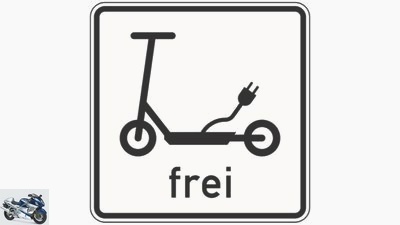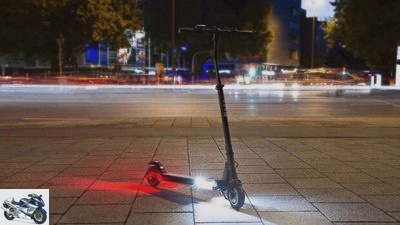Table of contents
- Operation of small electric vehicles legalized E-scooter regulation comes into force in June 2019
- Federal Council approved eKFV on May 17th
- Where can I ride an e-scooter?
- No helmet requirement
- opinion poll
- Driving with a helmet recommended

Adobe Stock
counselor
traffic & business
E-Scooter Act comes into force in June 2019
Operation of small electric vehicles legalized
E-scooter regulation comes into force in June 2019
Small Electric Vehicle Ordinance (eKFV) is the correct term for the often cited e-scooter law, which is supposed to have no less effect than the traffic revolution in German cities. At the
Dina Dervisevic
05/22/2019
With the new eKFV, the driver’s license requirement for small electric vehicles is no longer necessary – this is probably the most resounding innovation brought about by the law. At the end of February, Transport Minister Andreas Scheuer signed the ministerial draft of the regulation.
Federal Council approved eKFV on May 17th
At the beginning of April, the notification at European level was completed, according to the notification from the Federal Ministry of Transport and Digital Infrastructure dated April 3, 2019.
The Federal Council waved the Small Electric Vehicles Ordinance through at its meeting on May 17, 2019, but with a few changes. On May 22nd, government spokesman Steffen Seibert tweeted: “The Cabinet has passed the Small Electric Vehicle Ordinance; it should come into force in mid-June. “

Schematic representation of the insurance sticker (5.28 cm x 6.5 cm) with hologram. Source: escooter.blog
Changes requested by the Federal Council
The state chamber, i.e. the Federal Council, only approved the Small Electric Vehicles Ordinance (eKFV) under the following conditions:
– A maximum speed of 20 km / h applies to all e-scooters.
– E-scooters may only be driven from the age of 14. The ministerial draft provided for a second e-scooter class, which should also be allowed for twelve- and 13-year-olds with a top speed of 12 km / h, but that is now off the table.
– E-scooters are not allowed to drive on the sidewalk or in pedestrian zones, but only on bike paths. If there is no bike path, then – as for cyclists: hit the road. Driving on one-way streets in the opposite direction is permitted if it is also free for cyclists.
– Instead of an insurance number like on mopeds or small scooters, an insurance sticker on the vehicle is sufficient to provide information about the existing liability insurance.
Where can I ride an e-scooter?

Draft for the Small Electric Vehicle Ordinance “Small electric vehicles with a maximum design speed of not less than 12 km / h are free”. Source: escooter.blog
E-scooters can and should use the same traffic space as bicycles. So you are allowed on cycle paths and cycle lanes. If these are not available, the road can be used. One-way streets may be used in the opposite direction if this is also allowed for cyclists.
Dimensions: The e-scooter can be a maximum of 70 cm wide, 140 cm high and 200 cm long, while the weight must not exceed 55 kilos. The continuous output may be a maximum of 500 watts, 1,400 watts if 60 percent of the output is used for balancing (gyroscopic systems).
No helmet requirement

Moovi
Moovi is a German manufacturer of e-scooters based in Hanover. The Moovi e-scooter costs from 599 euros.
In order to be considered a small electric vehicle, the e-scooter must have a handlebar or handrail, a front, a rear and a brake light and two brakes that work independently of each other. A “lightening bell” must also be on board, but helmets are not required. The electric scooter does not have to have indicators either, the direction is indicated by a hand signal, just like when cycling.
opinion poll
Are you considering an e-scooter as a means of transport for short distances??
Voted 1685 times
Yeah sure why not.
No, an e-scooter won’t get under my feet.
I’ve been driving one for a long time.
Driving with a helmet recommended
There is currently a lot of discussion in the USA about whether it makes sense to wear a helmet. Current occasion: A study by US consumer protection has shown that the number of head injuries in emergency rooms has increased since e-scooter sharing was introduced in some cities. The number of people injured in accidents involving electric scooters in the USA since the end of 2017 is estimated at over 1,000.
Background: E-scooters that are used via a sharing provider, i.e. a rental company, are usually piloted without a helmet. Sure, because the use usually happens spontaneously. The same applies to e-scooters for private use as to bicycles and e-bikes: Here, the drivers are usually wearing a helmet, as the journey is usually planned (at short notice) and started from home, where a helmet is usually at hand. We reported about it on motorradonline.de.
Related articles
-
Catalog of fines for e-scooters: The cost of e-scooter sins
Adobe Stock counselor traffic & business Catalog of fines for e-scooters: The cost of e-scooter sins Catalog of fines for e-scooters E-scooter sins cost…
-
E-scooter in check: is an electric scooter something for me?
Svenja Faust counselor technology & future E-scooter in check: Is an electric scooter something for me? Everything about e-scooters Is an electric…
-
Even more electric BMWs – new e-scooters from autumn 2019
BMW 3 pictures BMW 1/3 The new BMW e-scooter will be available from autumn. BMW 2/3 It drives up to 20 km / h and 12 kilometers. BMW 3/3 The basic price…
-
E-scooter USA caused the accident
Adobe Stock counselor traffic & business E-scooter USA caused the accident E-scooter caused the accident Over 1,000 injured in the United States The…
-
Mobi-Ion AM1 e-scooter with fuel cell
Mobi-Ion 7th pictures Mobi-Ion 1/7 The French company Mobi-Ion has presented an electric scooter with fuel cell drive. Mobi-Ion 2/7 The AM1 in this form…
-
York’s s1-elite e-scooter – test drive with a near-series prototype
Svenja Faust 20th pictures Svenja Faust 1/20 20 km / h doesn’t sound like much, but with the right acceleration it gets down to business quickly. Svenja…
-
Aprilia eSR1 turns out to be an e-scooter
Aprilia 11 pictures Aprilia 1/11 As the name “Aprilia eSR1” was recently protected as a word mark by the European Patent Office, we speculated on an…
-
Harley-Davidson Electric Bike LiveWire 2019
Harley-Davidson 18th pictures Harley-Davidson 1/18 The production version of the electric Harley will roll onto the German market in September 2019. It…
-
E-scooter with exchangeable battery from Niu
Niu 21 pictures Niu 1/21 Niu is launching the new MQi GT and is offering an early bird discount. Niu 2/21 400 euros can be saved on the purchase … Niu…
-
Electric Night Ride 2019 in Stuttgart: Exit for electric two-wheelers
© 2019 ENR • Powered by WPKoi Sports & scene Events Electric Night Ride 2019 in Stuttgart: Exit for electric two-wheelers Electric Night Ride 2019 in…